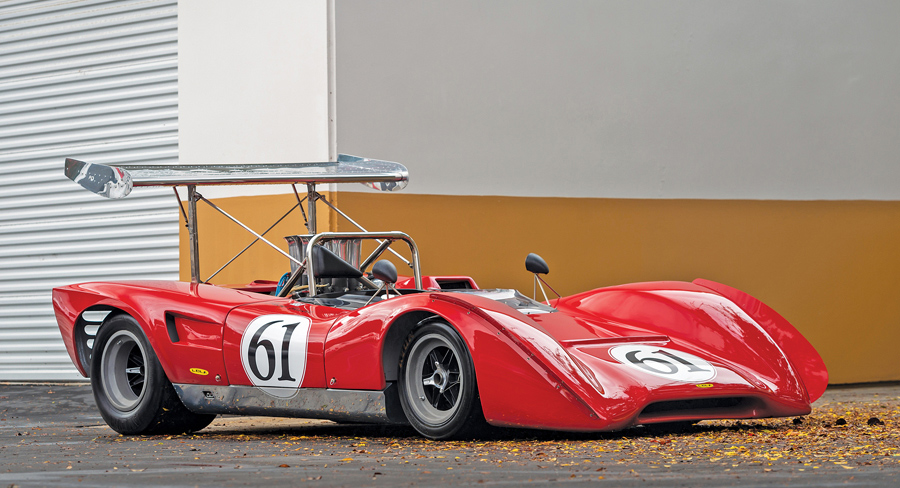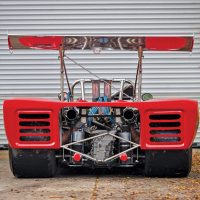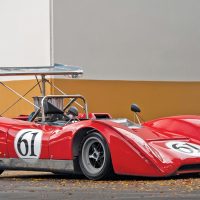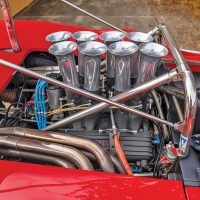SCM Analysis
Detailing
| Vehicle: | 1970 Lola T165 Can-Am Race Car |
This car, Lot 213, sold for $665,000, including buyer’s premium, at RM Sotheby’s Amelia Island FL, auction on March 7, 2020.
There are two old homilies that seem to relate to this particular sale:
Only old men and fools try to predict auction results for racing-car sales.
The exception proves the rule.
In this case, as an experienced hand in the business, I would never have encouraged an advisee to put a rather ordinary Lola Can-Am racer up for sale at any but a few auction venues (and particularly not Amelia Island).
Instead, I would have said giving it to one of the four or five really good racing-car brokers out there would increase the chances of an excellent sales price.
Further, I would have made a clear case that something like $300,000 would be a reasonable place to set expectations.
Obviously, I was wrong, by a factor of two or three.
Now, I admit to being 74 years old, which ain’t particularly young, but I would vigorously contest the fool part, as there is simply too much experience (much of it painful) contributing to my observations to dismiss them as senility.
Plus, virtually every other “expert” would have told you the same thing. Something beyond rational markets playing out had to apply here — possibly some parties made a huge mistake (and there had to be two bidders to get there).
There may have been something else going on, or maybe it wasn’t sold as a racer. As an “objet d’art,” maybe it was sold according to a different set of rules. Let’s consider.
A bit of history
American road racing developed through the 1950s as a purely amateur sport, but the post-war boom put lots of money in the hands of lots of people who had grown up with the automobile as their primary obsession — and excitement as a goal. So promoters quickly figured out that the explosion in circle racing that had found eyes and spectator dollars in the Southeast and Midwest could be packaged to the wealthier and better-educated demographic around the big cities and coasts.
For American road racing to capture the minds and wallets of our demographic, it needed to find the sex and allure of European racing and combine it with the ground-pounding and pulse-thumping spectacle of the American vibe.
Technology had proven to be a fortuitous companion, because in the mid-1960s the tire wars between Goodyear and Firestone had led to the development of very wide, short tires that could get immense amounts of horsepower to the road — which allowed big American V8 engines to strut their stuff.
The solution was the introduction of the “Canadian-American Challenge Cup,” or Can-Am, for the 1966 season. In the interest of spectacle, there was only one class and one winner. For the same reason, the rules abandoned any pretense of being limited to sports cars or in any other way. The basic technical rules were as follows:
- Two seats
- Four wheels
- Full bodywork
That’s it. Being faster was the only thing that mattered.
Oh, yeah, the prize money made even the biggest European races look like beggars taking alms.
The new series was an immediate and shattering success. The “classic” (which is to say unlimited) series ran from 1966 through 1974 before collapsing into something more regulated. This era can be thought of as four generations of racing cars.
The first generation was simply holdovers from USRRC. The engines were generally 5-liter and tires were still pretty skimpy, which limited how hard you could push them. Lola won the first year with their T-70.
The 1967 season saw the introduction of the 2nd Series cars with chassis designed specifically for Can-Am. They were now designed to accept Chevrolet’s “big block” engines, there was suspension room for tons more tire, brakes got huge, and aerodynamics were considered from the start — although wings were still added on. McLaren’s entry to this group was the M6A, and Lola introduced the T160 series. McLaren won easily in 1967.
The 3rd Series of racers, built between 1969 and 1971, compose what most of us think of as the glory years of Can-Am racing. McLaren’s M8 Series dominated, followed at some distance by Lola’s T165 designs. Wings started out tall and separate, but starting in 1970, they had to be integrated into the bodywork. This was a period of utter McLaren dominance, with Lola’s final T165 cars relegated to spear-carrier status. They were still great cars with lots to recommend them, particularly as fun drivers, but they couldn’t win.
McLaren won everything through 1971.
The 4th Series saw the introduction of Porsche’s 917-10 and 917-30 racers. They were overwhelming to the degree that the other competitors just went home, and Can-Am died.
Very cool — but not very collectible
So where does this discussion lead to our subject T165? The first answer is that, with the exception of a very few championship-winning McLaren chassis (and, of course, the Porsches, which are a different story), these Can-Am cars simply don’t cross the collectibility threshold.
They were pure weapons, with all components (except possibly the chassis tag) both disposable and readily disposed. For probably 85% of any Can-Am vintage grid, originality is pretty much a crock, with the result that few — if any — even claim to care. These are fabulous toys if you’ve got the wherewithal and desire to strap yourself in, but they are not now, or likely to be in the future, collectible in a classic way.
Our subject Lola is a pretty — but utterly un-special — example of the marque. Unless there is something I don’t know about, this should be a $200,000–$300,000 car — along with virtually every other weapons-grade Can-Am car sold for the past 10 years.
What might I have missed? The catalog clearly mentions it having a 427-ci engine, which is inappropriate (should be an aluminum 454), so maybe the engine is an original Chevrolet Corvette Grand Sport unit or the like, which could change the valuation massively.
The car is unquestionably gorgeous, so maybe it got bought as pure art (it’s not a lot of money from that perspective). Maybe a couple of tipsy high rollers were playing chicken and one lost. Maybe the car has special meaning to the winner, who just didn’t care what he paid.
To any normal way of valuation, this sale didn’t make sense, but somebody was willing to do it.
You never know. This sale was just before the market crash, so maybe a buyer dumped a mess of low-basis, high-volatility stock to pay for it and is now looking at his gorgeous Lola, sipping a scotch, and giggling. For whatever reason, I’ve got to say this was extremely well sold. I hope it made sense to the buyer. ♦



